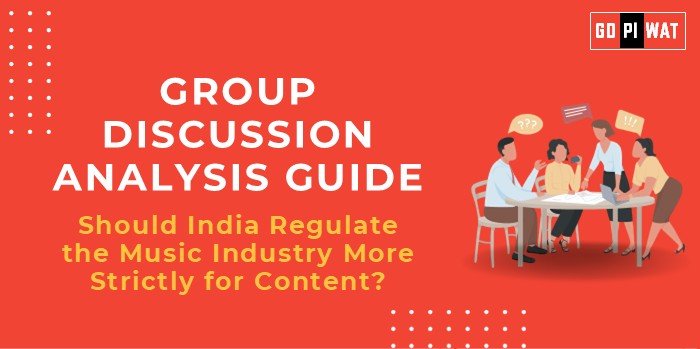🎶 Group Discussion Analysis Guide
Should India Regulate the Music Industry More Strictly for Content?
🌟 Introduction to the Topic
Opening Context: Music is a cultural cornerstone and a powerful medium for expression. However, concerns over explicit, harmful, or misleading content have sparked debates about the need for stricter regulations in India.
Topic Background: The Indian music industry, valued at approximately ₹2,000 crore, is growing rapidly due to digital platforms. While the freedom of expression is a fundamental right, balancing this with societal norms and safeguarding public interest remains a challenge.
📊 Quick Facts and Key Statistics
- Industry Value: ₹2,000 crore (2023) – Reflects the significance of the sector in the entertainment economy.
- Streaming Boom: 450 million active music app users – Indicates the reach and influence of digital music.
- Regulation Gaps: No uniform content rating system for songs – Highlights regulatory lacunae.
- Censorship Impact: 60% of complaints in media pertain to content vulgarity (IBF, 2023).
👥 Stakeholders and Their Roles
- Government: Formulates policies to regulate harmful content while upholding free speech.
- Music Producers and Artists: Create content and ensure compliance with societal norms.
- Consumers: Influence demand for ethical and appropriate content.
- Streaming Platforms: Moderate content through AI and manual review.
🎯 Achievements and Challenges
- Achievements:
- Cultural Promotion: Indian music is a global soft power, contributing to cultural diplomacy.
- Digital Growth: Streaming platforms expand access and diversity.
- Employment Generation: Provides livelihoods for thousands in the creative economy.
- Challenges:
- Vulgarity: Increasing explicit lyrics raise concerns among traditional communities.
- Lack of Regulation: Absence of clear legal frameworks for content curation.
- Comparative Insights: Countries like the UK have stringent music ratings and oversight mechanisms.
📌 Structured Arguments for Discussion
- Supporting Stance: “Regulation ensures that music upholds societal values and prevents cultural degradation.”
- Opposing Stance: “Strict regulation could stifle creativity and restrict freedom of expression.”
- Balanced Perspective: “A nuanced approach balancing artistic freedom with societal welfare is crucial.”
🚀 Effective Discussion Approaches
- Opening Approaches:
- “India’s music industry, with its vast audience, requires a balance between creative freedom and societal accountability.”
- “The rise in explicit lyrics and visuals raises critical questions about content regulation.”
- Counter-Argument Handling:
- Acknowledge the economic significance of creativity.
- Highlight successful examples of regulated yet thriving industries (e.g., films).
📈 Strategic Analysis of Strengths and Weaknesses
- Strengths: Cultural diversity, growing global presence.
- Weaknesses: Lack of content oversight, cultural clashes.
- Opportunities: Develop industry standards, AI moderation tools.
- Threats: Boycotts, legal challenges.
🎓 Connecting with B-School Applications
- Real-World Applications: Exploring music’s role in brand marketing or cultural policy discussions.
- Sample Interview Questions:
- “What challenges do industries face when balancing regulation with creativity?”
- “How can AI support content moderation in the music industry?”
- Insights for Students: Examine music’s impact on consumer behavior and its potential for societal influence.


